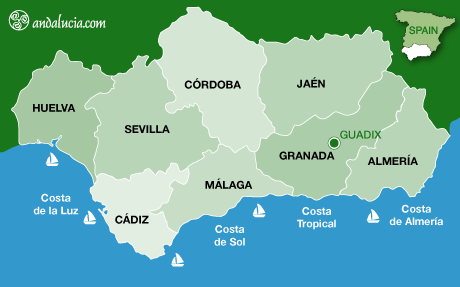
The village and the caves of Guadix |
|
Guadix
The cathedral town of Gaudix is well off the beaten path, in the eastern confines of the Province of Granada, a large, bustling country town with a personality all of its own. Its history dates back to Phoenician and Roman times, and it played a major role in the Reconquest.
The most interesting feature of the Guadix area is that many of the inhabitants of this large town live underground, in the southern part of the town, in what are known as cave houses. The jagged ochre terrain and the dazzling whitewashed chimneys and doors of the caves contrast dramatically with the snow-covered peaks of the Sierra Nevada, which loom above. The cave district is signposted on the main street of the town as the "Barrio Troglodyte".
History
The city of Guadix has been inhabited since the mid-second millennium BC, and continues to be so to this day. Caesar founded the Ivlia Gemella Acci colony in 45 BC, shortly after the Battle of Munda, to house veterans of the Regio Prima Uernacula and the Regio Secunda. This settlement had a Hippodamian plan with fundamental axes known as the cardus and the decumanus. These axes can still be seen in the city today and have shaped the medieval and modern city. Roman features present here include the hydraulic infrastructure, thermal baths and the necropolises that have been discovered, the latter of which are located in the Convento La Concepción and the Plaza de Osario. More>
Things to See
Many of the inhabitants of Guadix live underground, in cave houses. In the winter they are covered with snow and keep their warmth, providing delightful places to stay, often with their own… More →
Cascamorras festival in Guadix and Baza has been declared Fiesta de Interés Turístico Internacional (Festival of International Tourism interest) due to its intriguing history. Although the… More →
The Church of La Magdalena, located in the historic neighborhood of the same name, holds great historical and architectural value. Built from the mid-16th century on the site of the former… More →
The Antigua Lonja, or Old Exchange, once served as a centre for business meetings, commercial transactions and banking in Guadix. Today, only the façade remains, featuring the coat of arms of… More →
The Roman Theatre of Colonia Iulia Gemella Acci is one of Guadix’s most remarkable archaeological sites. Built in the early 1st century AD, the theatre formed part of a monumental complex covering… More →
Guadix is considered the ‘European Capital of Caves’ due to its 2,000 underground dwellings spread across 200 hectares. Around 4,500 residents still live in these cave houses, which maintain a… More →
The Cathedral of Guadix, built on the so-called ‘Sacred Hill’, stands on the site of a former Visigothic cathedral and later an Arab mosque. Constructed between the 16th and 18th centuries, it is… More →
The Palacio de Villalegre is one of Guadix’s most emblematic buildings. Built by the Fernández de Córdoba family on the site of a former Muslim residence, it later passed through several noble… More →
The Church of Santiago, designed by the architect and sculptor Diego de Siloé, is one of the most beautiful examples of religious architecture in Guadix. Built on the model of a traditional… More →
The Casa Consistorial, or Town Hall, represents the transformation of Guadix into a true Renaissance city. Originally built between the late 16th and early 17th centuries, it centralised political… More →
The Church and Convent of La Concepción, dating back to 1655, is one of the oldest in Guadix. Despite suffering several fires, it retains its original 16th-century structure with a central… More →
The Palacio de Peñaflor belonged to the Pérez de Barradas family, Marquesses of Cortes and Graena, who settled in Guadix after the Reconquista. The building is currently being considered for… More →
Things to see nearby

Cave dwellings
The area is famous for its hand-crafted earthenware, which is sold on the roadside in the nearby village of Purullena.
The desert landscape around the village of Benalúa de Guadix is especially impressive, and well worth a drive through the region. If you wish to explore this fascinating area more thoroughly, you can also drive from Benalúa de Guadix to the Spa called "Baños de las Alicun de las Torres" returning on the first road on the right after leaving the spa, which will take you back to the A-92 Motorway. The total drive takes between 90 minutes and 2 hours.
The fascinating Castle of the Calahorra in the village of La Calahorra, just a few miles to the East. This impressive fort was awarded to a Christian knight for his role in the Reconquest, and fitted by him with a gracious Renaissance courtyard made of Italian marble and by Florentine craftsmen. To get there, leave Guadix in the direction of Almería on N-324. You will soon be treated to the spectacular view of the round towers of the castle framed against the towering Sierra Nevada, which so often features in photographs and posters.
